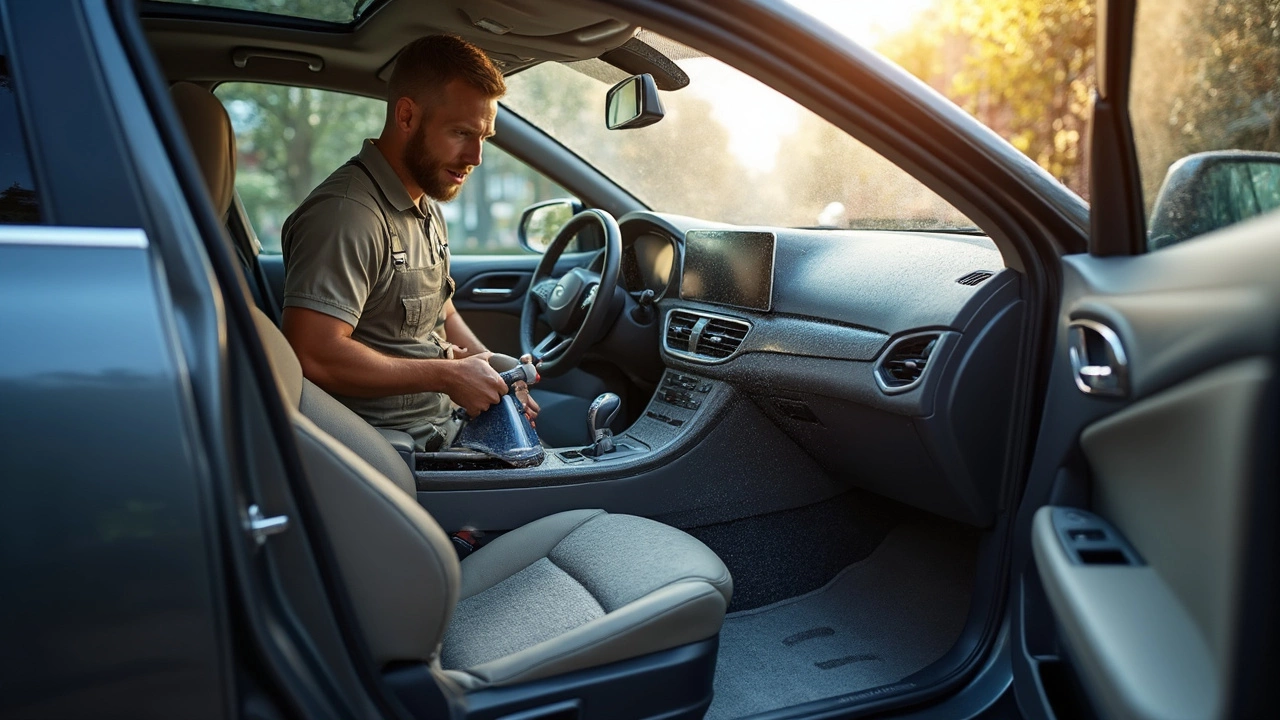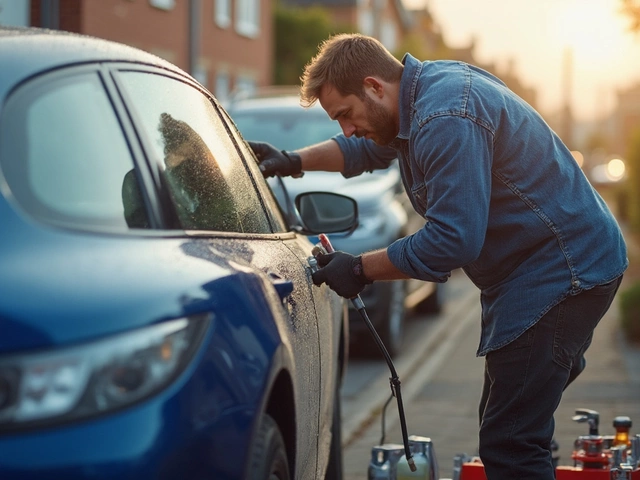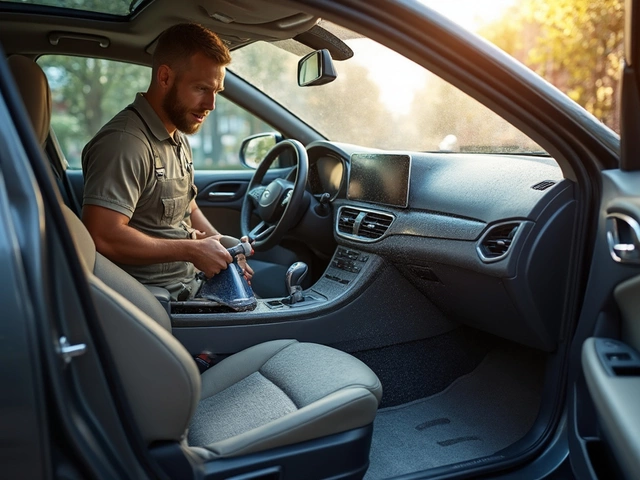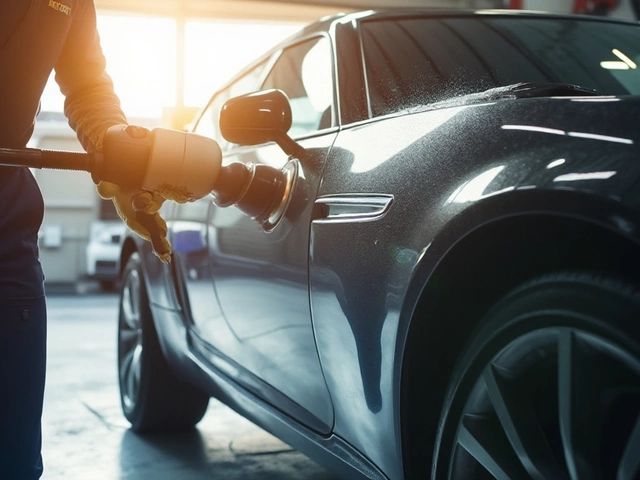Ever sat in a freshly detailed car and wondered, “How did they get it so spotless?” There’s a big difference between a quick wipe-down and the deep clean the pros do. Detailers have a lineup of gear and products that most car owners haven’t tried.
First off, the average detailer doesn’t just use one cloth and some water. They have a range of brushes, scrub pads, microfiber towels (and yes, quality matters), and specialty vacuum attachments built for every space—think tight cups holders and crusty seat seams. If you want to get anywhere near pro-level results, the right tools make all the difference between ‘it’s clean enough’ and ‘wow, who drove this car last?’
- Core Interior Detailing Tools
- Essential Cleaning Products
- Pro Tips for Tackling Tough Spots
- Must-Have Items in Every Detailing Kit
Core Interior Detailing Tools
Detailers don’t mess around with the basics. Their toolkit covers things you probably didn’t even know existed, and each one serves a real purpose when deep cleaning a car’s cabin. If you’ve only been using an old rag and a drugstore vacuum, you’re missing half the battle. Here’s what the pros won’t live without:
- Microfiber towels – These snag every bit of dirt and trap dust. Cheap towels can actually scratch surfaces or just push dirt around, so detailers invest in high-quality ones (300+ GSM thickness for the nerds out there).
- Soft bristle detailing brushes – These are perfect for vents, buttons, and those tight spots full-sized tools can’t reach.
- Heavy-duty shop vacuums – Forget your household vac. Good detailers rely on strong suction and all sorts of specialty attachments to clean under seats, in between crevices, and inside every cup holder.
- Steam cleaners – For stubborn grime and germs, nothing beats a handheld steamer. It lifts gunk without harsh chemicals and is a secret weapon for things like floor mats and fabric door panels.
- Scrub pads and magic erasers – These tackle things like scuff marks on plastic or sticky residue in consoles.
- Compressed air tools – For blowing out crumbs and dust deep in dash vents and under seats. You can’t always see what’s under there, but you sure notice when it’s gone.
According to the International Detailing Association, “The average pro detailer uses at least 4 separate brushes and 5 types of microfiber during a single car interior job.”
“The right tools aren’t just about getting the job done faster—they prevent scratches and make your products work better.” — International Detailing Association
There’s data to back it up, too. Look at this:
| Tool | Main Use | Boosts Cleaning Efficiency (%) |
|---|---|---|
| Shop Vacuum | Deep suction, crevice cleaning | 80 |
| Steam Cleaner | Lifting stains, killing germs | 75 |
| Microfiber Towels | Dust trapping, gentle wiping | 70 |
If you’re building your own car detailing kit, this core lineup is where you should start. Every tool on this list is there for a reason, and skipping any of them usually means missing a spot or risking damage to something inside your ride.
Essential Cleaning Products
When you peek inside a pro’s car detailing kit, you’ll see more than random sprays and wipes. Top detailers are picky about their interior cleaning products, because every surface needs the right stuff to avoid damage and get dramatic results.
Let’s break down what you’ll usually find in their arsenal:
- All-purpose cleaners: These are lifesavers for cleaning dashboards, plastics, and even some fabrics. Meguiar’s D101 or Chemical Guys All Clean+ pop up in a ton of pro setups because they’re tough on grime but still safe when diluted right.
- Glass cleaners: Streaky windows ruin the whole look. Pros stick with ammonia-free formulas like Stoner Invisible Glass or Griot’s Garage Glass Cleaner so they don’t mess up tint or leave residue.
- Dedicated upholstery cleaners: Fabric and carpet get gross. Foaming sprays like Sonax Upholstery & Alcantara Cleaner or Turtle Wax Upholstery Cleaner dig out stains without soaking the seat foam.
- Leather cleaners and conditioners: If your interior has leather, it needs different treatment. Lexol and Chemical Guys Leather Cleaner get the dirt out, while conditioners keep seats soft instead of cracked.
- Odor eliminators: Not just air fresheners. Products like Meguiar’s Whole Car Air Re-Fresher actually kill smells instead of just masking them.
Here’s a quick snapshot of what the pros reach for. If you’re trying to build your own setup, these make a solid starting point:
| Product Type | Popular Example | Main Purpose |
|---|---|---|
| All-Purpose Cleaner | Chemical Guys All Clean+ | General interior and surface cleaning |
| Glass Cleaner | Stoner Invisible Glass | Spotless, streak-free windows |
| Upholstery Cleaner | Sonax Upholstery & Alcantara Cleaner | Stains and spills on seats & mats |
| Leather Cleaner | Lexol Leather Cleaner | Safe treatment for seats and trim |
| Odor Eliminator | Meguiar’s Air Re-Fresher | Removes stubborn smells |
Mixing the right products and not just grabbing the nearest spray bottle matters. Using an APC (that’s what pros call All Purpose Cleaner) on your leather or infotainment screen can do more harm than good. Always check the label and test a small spot before blasting an entire area. If you want to come close to a professional auto detailer finish, matching the product to the surface is half the battle.

Pro Tips for Tackling Tough Spots
Dealership-level clean isn’t about luck—it’s about tackling the chaos that sneaks into car interiors. Stubborn gunk and weird stains? Pros don’t just scrub harder; they use targeted moves and the right gear from their car detailing kits.
For stuck-on food in cup holders or melted candy in the creases, detailers will often use a steam cleaner. The steam blasts grime loose and kills germs, and it works way better than just hot water or wipes. For pet hair (somehow it gets everywhere, right?), they’ll use a rubber brush or even a pumice stone to pull those stubborn hairs out of carpets and cloth seats, then follow up with a high-powered vacuum.
When it comes to spills, like coffee or soda on upholstery, you’ll see pros reach for a special enzyme cleaner. These break down stains at the source—no just masking the smell. Here’s a quick fix any car owner can use for emergency spills:
- Blot up excess liquid with a microfiber towel (don’t rub, you’ll just spread it!)
- Spray on enzyme cleaner or, in a pinch, a mix of water and white vinegar
- Let it sit for 5-10 minutes to work its magic
- Gently scrub with a soft brush, then blot again to lift the stain
Those weird mystery stains, especially on headliners, are delicate work. A detailer might spray a little all-purpose cleaner on a microfiber towel (not directly on the headliner), dab at the spot, and leave it at that—too much moisture and you risk sagging fabric.
If you’re battling sticky stuff like gum or crayon, pros often freeze it first with an ice pack, then chip it away with a plastic scraper. For scuffs on plastic door panels or consoles, they’ll use a magic eraser—but only lightly, since it can dull shiny surfaces if you go too hard. Here’s a quick cheat-sheet table:
| Tough Spot | Pro Move |
|---|---|
| Pet Hair | Rubber brush + powerful vacuum |
| Coffee Stain | Enzyme cleaner + blot with microfiber towel |
| Sticky Mess | Freeze then chip off with plastic scraper |
| Door Scuffs | Magic eraser, gently applied |
When nothing else works, detailers sometimes use a specialized extractor (kind of like a mini carpet cleaner) for deep-seat spills. If that sounds like overkill, just remember, these folks have seen everything—from milkshakes to mystery slime. That’s why they have all the right tricks.
Must-Have Items in Every Detailing Kit
If you open up any legit car detailing kit, you’ll spot a few staples that pros always keep on hand. These aren’t just random products—they’re chosen because they work, save time, and don’t wreck your interior. Here’s what you should be looking for if you want pro results at home.
- Microfiber Towels: It’s not up for debate—microfiber is gentle, super absorbent, and actually picks up dirt instead of smearing it around. Get a bunch, and don’t just use one for everything. Pros separate towels for leather, glass, and dash.
- Soft-Bristle Brushes: Different sizes matter. Bigger ones go after floor mats or seats, tiny ones nail down vent grills and seams. Nylon bristles work best for fabric and general plastic surfaces, while boar hair brushes are ideal for more delicate areas like touch screens and gauge clusters.
- Interior Cleaner: Grab a dedicated interior cleaning solution, not just all-purpose spray from your kitchen. These are made to lift stains and grime without drying out leather or scratching plastic trim.
- Vacuum with Attachments: Crevice tools and mini brushes for the vacuum are game-changers, helping you get deep into tight spots and under seats—places a standard home vacuum won’t reach.
- Glass Cleaner: Skip the ammonia-based stuff. Get a cleaner marked as “tint-safe” to avoid ruining your windows. Spray on the towel, never directly on the glass, to avoid overspray.
- Protectant: Once everything’s clean, detailers use a protectant for plastics, vinyl, and sometimes leather. This keeps your dash from cracking and gives that clean, “just-detailed” look for much longer.
| Item | Why It Matters | Pro Tip |
|---|---|---|
| Microfiber Towels | Prevents scratches & traps dirt | Wash regularly, don’t use fabric softener |
| Brush Set | Reaches all surfaces | Use separate brushes for leather & plastic |
| Vacuum Attachments | Deep-cleans tight spaces | Use the crevice tool for hard-to-reach debris |
Don’t forget air fresheners and deodorizing sprays. After all, smell is a huge part of that “new car” vibe. Stick to brands made for auto interiors—some household sprays can stain seats or leave sticky residue.
Last thing: keep your car detailing kit organized. Toss everything in a clear plastic bin that lives in your trunk or garage, so you’re ready for spills or dusty dashboards anytime. This makes quick touch-ups so much easier, and you’ll never find yourself hunting for that one brush or bottle you swore you just had.




